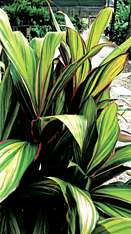Cordyline fruticose, a native to Southeast Asia, is often referred to as a ti plant or Hawaiian ti. Because the growing conditions are favorable in Hawaii for growing these plants, many of the varieties of cordylines are grown commercially there, even though the plant is not native to Hawaii.
These plants grow well in zones 10 to 12 and enjoy our warm, humid environment on the island. They are evergreen plants with beautiful foliage in a wide variety of colors that add a tropical splash of color to areas of your landscape where there is not enough sunlight to grow flowering plants. They like well-drained, fertile soil and partial sun/partial shade. Direct sun might burn the leaves of this plant.
Cordylines also do especially well in a container with a well-draining potting mix. With their beautiful glossy leaves in a variety of colors ranging from purple, red and pink to many shades of green, they make an interesting main plant for a container arrangement. One of my favorites is a smaller leaf variety called ‘kiwi’ with variegated leaves of green and lime and pretty pink edges along the leaves.
The kiwi always looks great in a pot with a couple other lower plants. Add a bromeliad with a pink center and a trailing pothos vine that spills over to create a fun container arrangement that will make an interesting addition to your porch or lanai.
Other varieties that do well in our area are Maria with wider pink leaves, bolero in combinations of pink green and white, a darker one called black magic which has chocolate-colored leaves mixed with green leaves and a variety called Auntie Lou which is more of a solid burgundy color.
As you can see, there is a lot of variety when it comes to selecting the cordyline for you. All these color choices and the tropical look of the foliage make this a fun tropical plant for your landscape, so show your colors and choose the cordyline that is right for you.
This column is a joint effort by all at In The Garden, Sanibel’s local garden center located at 3889 Sanibel Captiva Road, Sanibel Island, Florida.
